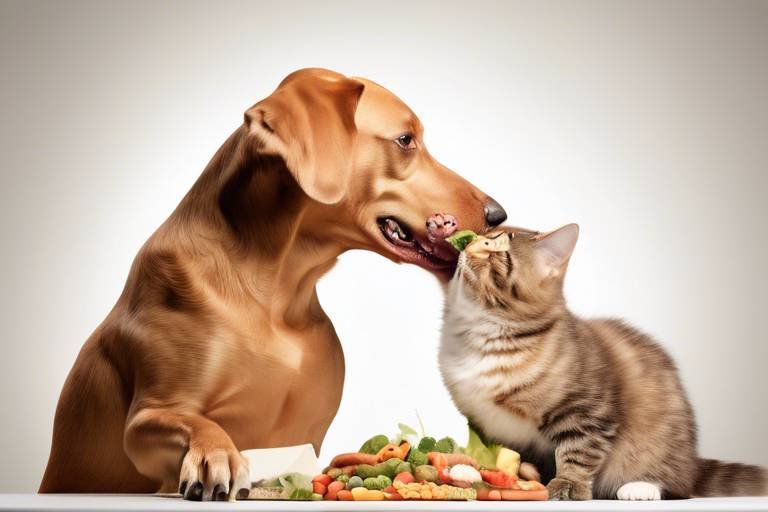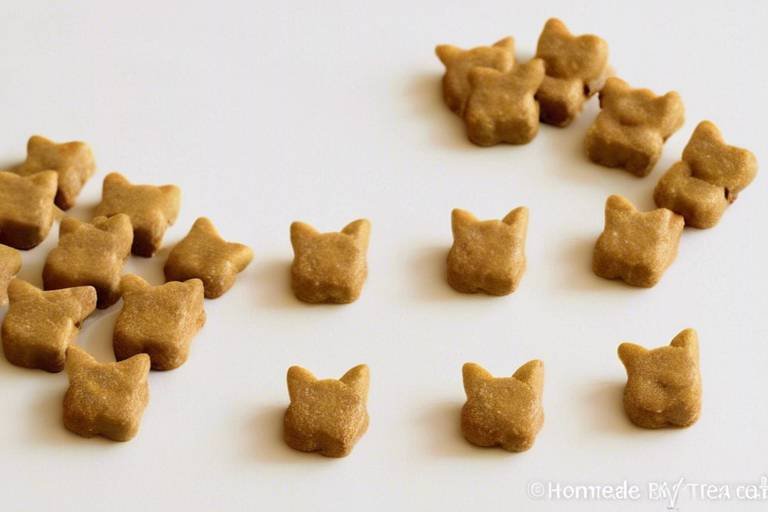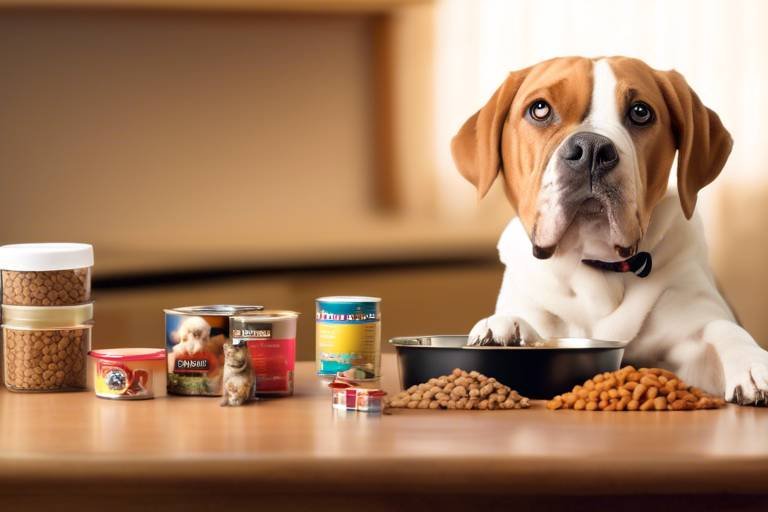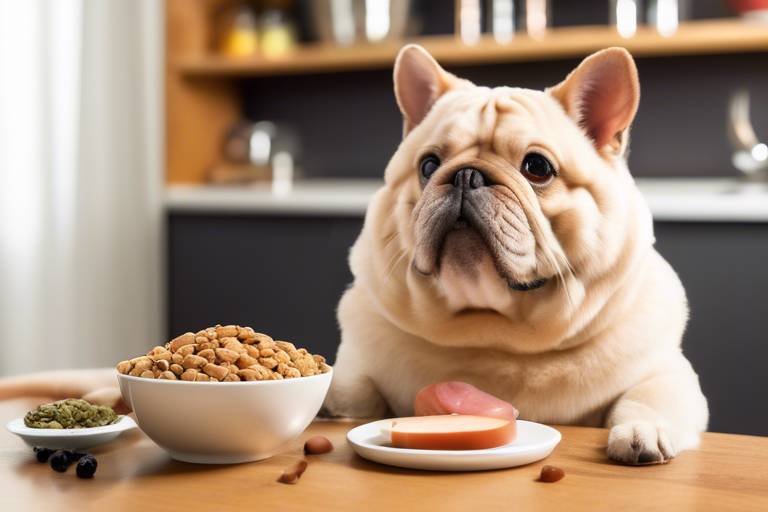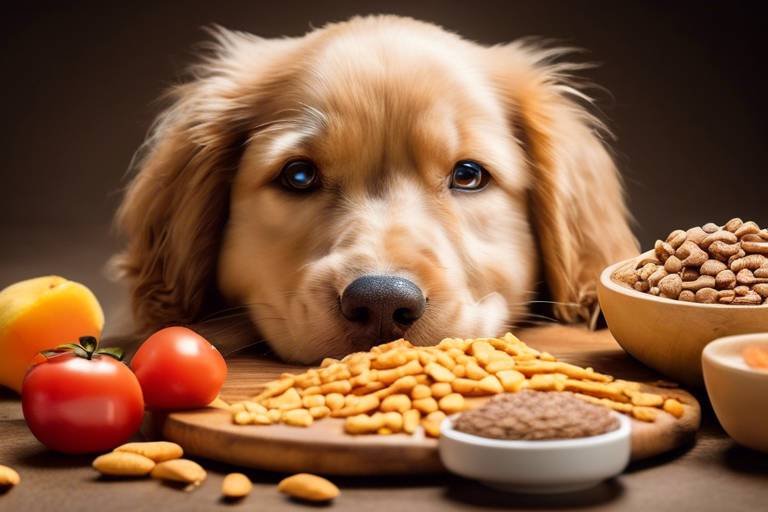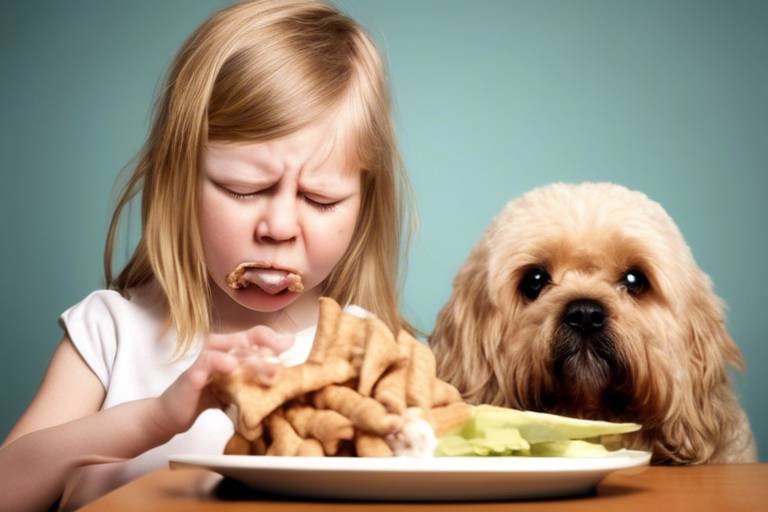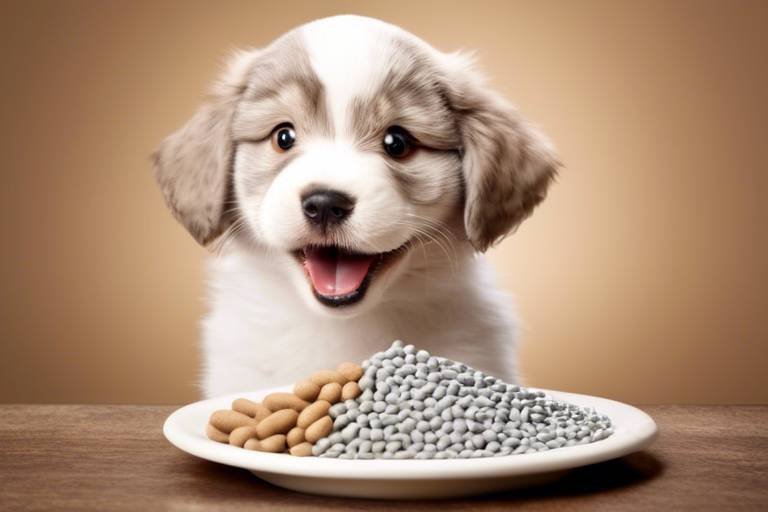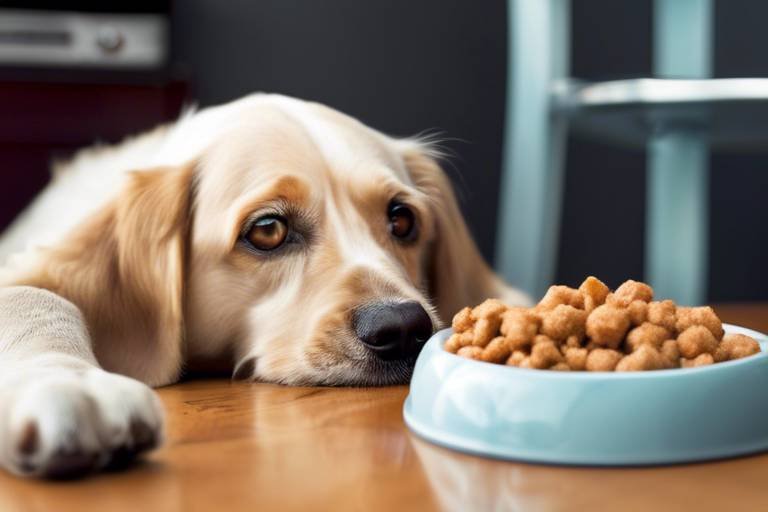How to Help Your Pet with Dietary Changes
Changing your pet's diet can feel like navigating a labyrinth, filled with twists, turns, and unexpected surprises. Just like us, our furry friends can be quite sensitive to changes in their food. Whether you’re switching from one brand to another or introducing a special diet for health reasons, it’s essential to approach this transition thoughtfully. After all, a happy pet is a healthy pet, and making dietary changes can be a pivotal part of ensuring their overall well-being. In this article, we’ll explore effective strategies to assist your pet during these dietary transitions, ensuring they adapt smoothly to new food options while keeping their health and happiness in check.
Before you dive headfirst into changing your pet's food, it’s crucial to understand their nutritional needs. Just like humans, pets require a balanced diet tailored to their specific circumstances. Factors such as age, breed, activity level, and existing health conditions can greatly influence what nutrients your pet requires. For instance, puppies need more protein and fat to support their rapid growth, while older dogs may benefit from diets lower in calories but rich in fiber to maintain a healthy weight. It's like finding the perfect recipe for a cake; you need the right ingredients in the right amounts to achieve the best results. So, take some time to assess your pet's unique dietary needs.
Recognizing when your pet is struggling with their current diet is vital. Symptoms such as vomiting, diarrhea, excessive scratching, or even changes in energy levels can indicate that something isn’t right. It’s important to be vigilant and attentive to these signs, as they can help you pinpoint whether a dietary change is necessary. Think of it as being a detective—your pet is giving you clues about their health. If you notice any of these symptoms, it might be time to reevaluate their food.
When it comes to dietary changes, the *slow and steady* approach is often the best. Implementing gradual changes can prevent gastrointestinal upset in pets, which can lead to discomfort and stress for both you and your furry companion. Imagine switching from a cozy blanket to a scratchy one overnight; it’s just not comfortable! To ease your pet into their new diet, consider mixing a small amount of the new food with their current food, gradually increasing the new food's proportion over a week or so. This way, your pet's digestive system has time to adjust.
Developing a structured schedule for transitioning your pet's food can ensure a smooth adjustment. Here’s a sample timeline you might consider:
| Day | Food Ratio |
|---|---|
| 1-2 | 25% New Food / 75% Old Food |
| 3-4 | 50% New Food / 50% Old Food |
| 5-6 | 75% New Food / 25% Old Food |
| 7+ | 100% New Food |
As you implement this transition schedule, it’s vital to observe your pet's behavior and health closely. Are they eating well? Do they seem energetic, or are they lethargic? Monitoring these aspects can help you identify any issues early on. If your pet shows signs of distress, such as refusing to eat or experiencing digestive troubles, it may be necessary to adjust the diet or consult a veterinarian. Think of it as being a coach; you need to keep an eye on your team’s performance to ensure they're on track.
Choosing the right food for your pet can feel like standing in front of a vast buffet—overwhelming and confusing. With so many options available, how do you know what’s best for your furry friend? When selecting food, consider factors like the ingredient quality, nutritional content, and any specific dietary needs your pet may have. Look for high-quality protein sources, healthy fats, and avoid fillers or artificial additives. It’s like picking the best ingredients for your favorite dish; quality matters!
Engaging with a veterinarian is key to making informed dietary decisions. They can provide valuable insights into your pet's specific needs and help you navigate the overwhelming world of pet food. Just as you would consult a doctor for your health, your pet deserves the same level of care. A vet can help you identify the best food options and even recommend brands that align with your pet's health requirements.
Deciphering pet food labels can be tricky, but it’s essential for ensuring you’re choosing the right food for your pet. Look for clear information about the ingredients, guaranteed analysis, and feeding guidelines. Remember, the first ingredient should ideally be a high-quality protein source. Understanding these labels is like reading a map; once you get the hang of it, you’ll feel more confident in your choices!
Food allergies can significantly affect your pet’s health. If you suspect your pet may have a food allergy, look for symptoms such as itching, gastrointestinal upset, or chronic ear infections. Identifying and managing these allergies during dietary changes is crucial. You might need to consult with your veterinarian to determine the best course of action, which could include a special hypoallergenic diet. Think of it as finding the right pair of shoes; they need to fit well to avoid discomfort.
- How long should I take to transition my pet to new food? Typically, a gradual transition over 7-10 days is recommended.
- What signs should I watch for during the transition? Look for changes in appetite, stool consistency, and energy levels.
- Can I mix different brands of pet food? It’s best to consult with your vet before mixing brands to ensure compatibility.
- What if my pet refuses to eat the new food? If your pet refuses to eat, consider reverting to the old food and consulting your vet for alternatives.
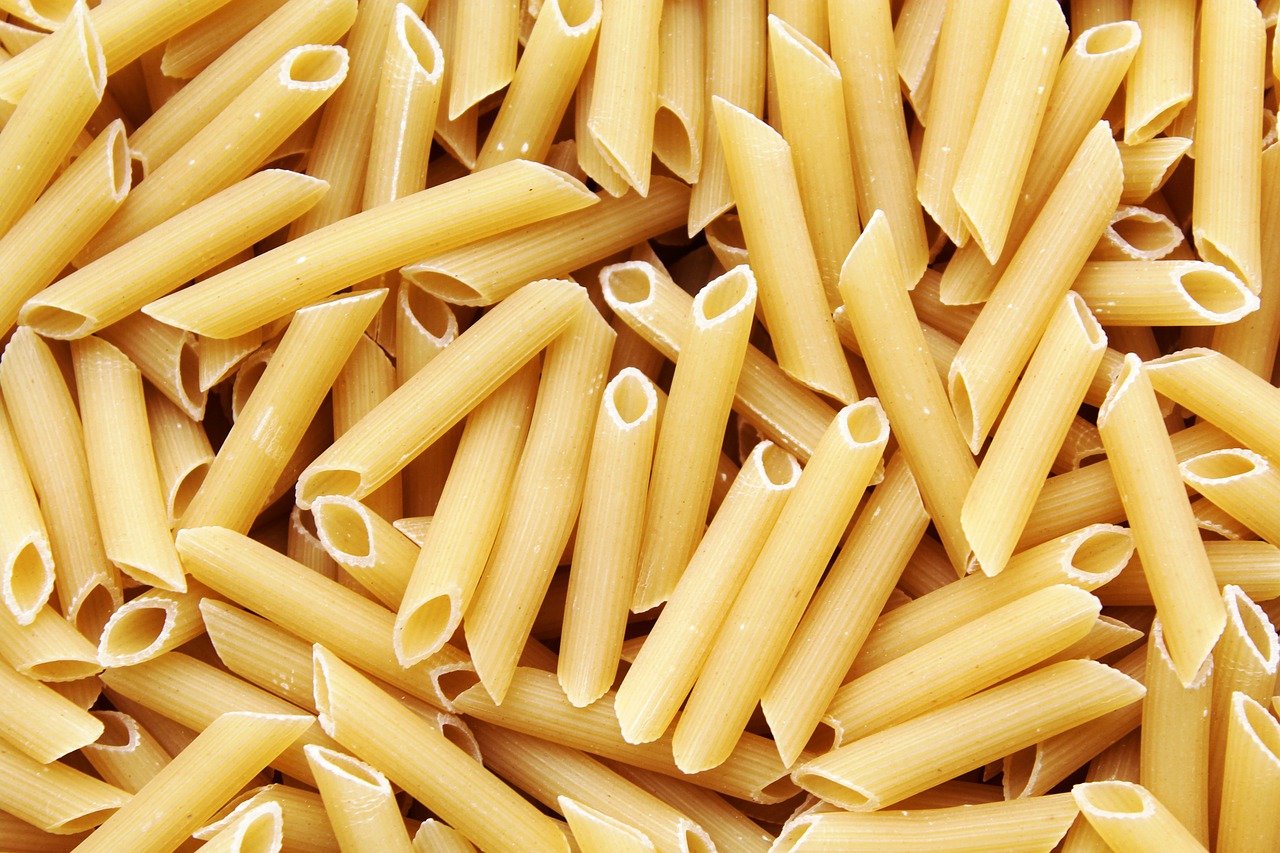
Understanding Your Pet's Nutritional Needs
When it comes to ensuring your furry friend is healthy and happy, understanding their nutritional needs is paramount. Just like humans, pets require a balanced diet that provides them with the essential nutrients they need to thrive. But how do you determine what those needs are? It’s not just about choosing the most colorful bag of kibble or the fanciest can of wet food. You have to consider several factors, including your pet's age, breed, and any specific health conditions they may have.
For instance, puppies and kittens have different dietary requirements compared to adult or senior pets. They need higher levels of certain nutrients to support their rapid growth and development. On the other hand, senior pets may require a diet lower in calories but rich in fiber to aid digestion and maintain a healthy weight. Additionally, certain breeds may be predisposed to specific health issues, which can also influence their dietary needs. For example, large breed dogs may need a special diet to help prevent joint problems.
To further understand your pet's nutritional requirements, it’s essential to familiarize yourself with the following key nutrients:
- Proteins: Vital for growth, repair, and overall health.
- Fats: Provide energy and support cell structure.
- Carbohydrates: Offer a quick source of energy and aid in digestion.
- Vitamins and Minerals: Crucial for various bodily functions, including immune response and bone health.
- Water: Often overlooked, but hydration is essential for every pet.
Each of these nutrients plays a unique role in your pet’s overall well-being. For example, proteins are the building blocks of life, helping to repair tissues and build muscles. Fats, while often feared, are actually essential for energy and nutrient absorption. Carbohydrates can provide a quick energy boost, especially for active pets. And let’s not forget about vitamins and minerals, which are critical for everything from bone health to immune function.
As you assess your pet's diet, it can also be helpful to consult with your veterinarian. They can provide tailored advice based on your pet's specific needs, helping you navigate the sometimes overwhelming world of pet nutrition. Remember, just like we have unique dietary needs, so do our pets, and it’s our responsibility to ensure they receive the proper nutrition to live a long, healthy life.
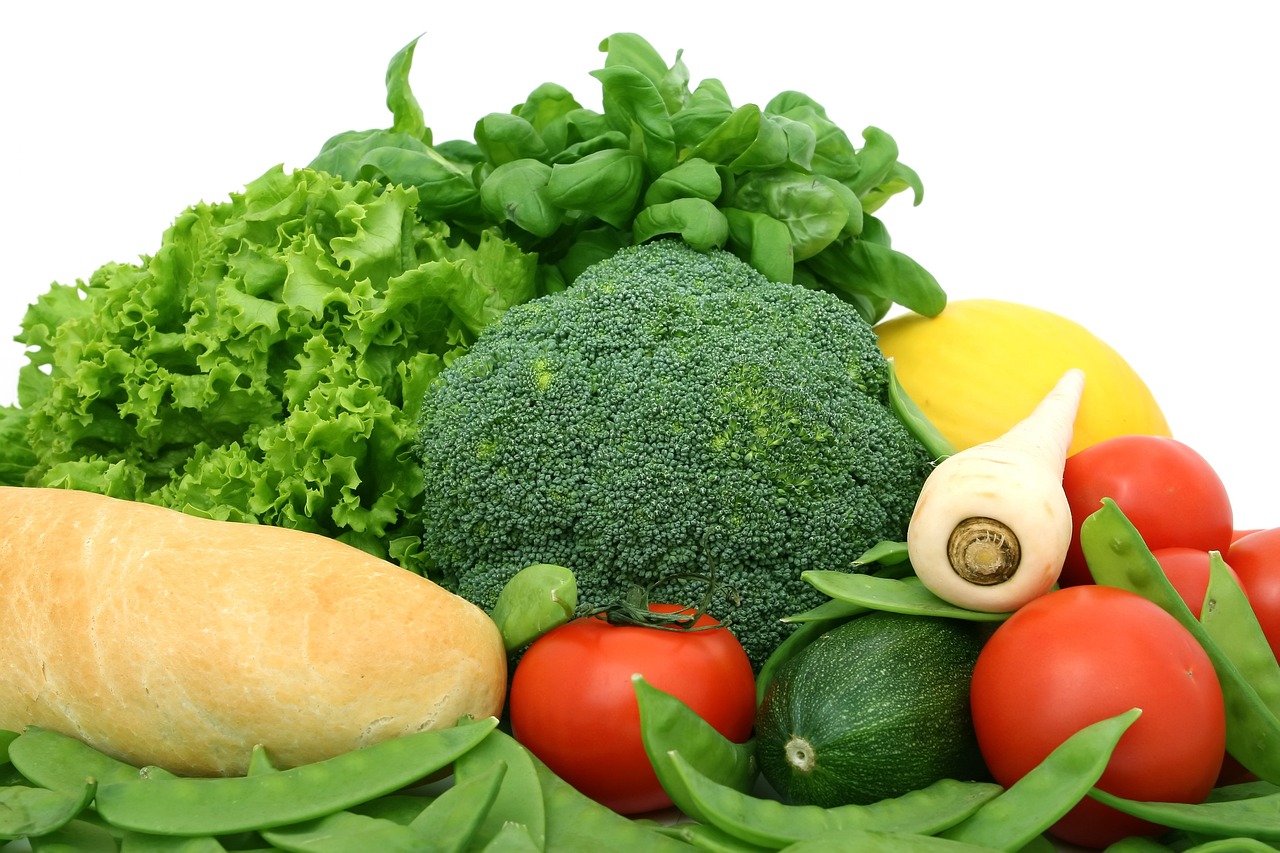
Identifying Signs of Dietary Issues
As a pet owner, it’s essential to be vigilant about your furry friend’s health, especially when it comes to their diet. Just like humans, pets can experience a myriad of issues related to their food. Recognizing the signs of dietary problems early can make a significant difference in your pet's overall well-being. So, what should you be looking out for?
First and foremost, changes in appetite can be a telltale sign. If your pet suddenly becomes disinterested in their meals or, conversely, starts eating voraciously, it might indicate an underlying dietary issue. Additionally, keep an eye on their weight. Sudden weight loss or gain can be alarming and often points to nutritional imbalances or food sensitivities.
Another critical aspect to observe is your pet's digestive health. Are they experiencing frequent vomiting or diarrhea? These symptoms can be distressing and may suggest that their current diet isn’t agreeing with them. It's important to note that a pet’s stool consistency can also reveal a lot about their dietary needs. Healthy stools should be firm and well-formed; any deviations could warrant a closer look.
Behavioral changes can also signal dietary issues. If your usually playful pup starts to exhibit lethargy or irritability, it may be time to evaluate their food. Pets rely on a balanced diet for energy, and an inadequate or inappropriate diet can lead to mood swings and decreased activity levels.
Other signs to be aware of include:
- Skin and coat problems: Dull fur or excessive shedding can be linked to nutritional deficiencies.
- Bad breath: This could indicate dental issues or dietary concerns.
- Excessive thirst or urination: These can be symptoms of underlying health issues exacerbated by diet.
It’s crucial to pay attention to these signs and act accordingly. If you notice any of these symptoms, it’s a good idea to consult with your veterinarian. They can provide tailored advice and help you determine if a dietary change is necessary. Remember, your pet relies on you to keep them healthy and happy, so being proactive about their diet can lead to a longer, more fulfilling life.
Q: How quickly should I change my pet's diet?
A: It's best to make changes gradually over 7-10 days to prevent gastrointestinal upset.
Q: What are some common dietary issues in pets?
A: Common issues include food allergies, sensitivities, and imbalances in essential nutrients.
Q: How can I tell if my pet has a food allergy?
A: Look for symptoms like itching, digestive upset, or chronic ear infections. Consult your vet for a proper diagnosis.
Q: Should I consult my vet before changing my pet's diet?
A: Yes, consulting with a veterinarian is crucial to ensure you choose the best diet for your pet’s specific needs.
The Importance of Gradual Changes
When it comes to changing your pet's diet, slow and steady wins the race. Just like humans, pets can experience digestive upset when they suddenly switch to a new food. Imagine if you were used to eating pizza every day and suddenly had to switch to a salad overnight—your stomach would probably protest! This is why it’s crucial to introduce new foods gradually.
Gradual changes allow your pet's digestive system to adapt to the new ingredients without overwhelming it. This process minimizes the risk of gastrointestinal issues such as vomiting, diarrhea, or constipation. A sudden change can be shocking to your pet's system, leading to discomfort and potential health problems. Instead, by easing them into their new diet, you create a smoother transition that promotes overall well-being.
To implement gradual dietary changes effectively, consider the following steps:
- Start Small: Begin by mixing a small amount of the new food with their current food. For example, if you're introducing a new kibble, start with about 25% new food and 75% old food.
- Increase Gradually: Over the course of 7 to 10 days, gradually increase the proportion of the new food while decreasing the old food. This gradual shift helps your pet's digestive system adjust.
- Monitor Closely: Keep an eye on your pet’s reaction during this transition. Look for any signs of distress or discomfort, and be prepared to slow down the process if necessary.
Here’s a simple transition schedule you can follow:
| Day | Old Food (%) | New Food (%) |
|---|---|---|
| 1-3 | 75 | 25 |
| 4-6 | 50 | 50 |
| 7-9 | 25 | 75 |
| 10+ | 0 | 100 |
By following a gradual transition plan, you not only ensure your pet's comfort but also set the stage for a happier, healthier companion. Remember, patience is key! If your pet is particularly sensitive or has a history of digestive issues, it might be wise to take even longer with the transition. After all, a content pet is a happy pet!
Creating a Transition Schedule
Transitioning your pet to a new diet is a bit like teaching a toddler to eat broccoli; it takes patience, understanding, and a solid plan. Just like humans, pets can be creatures of habit, and a sudden change in their food can lead to confusion and digestive distress. That’s why creating a well-structured transition schedule is crucial for a smooth adjustment. A gradual approach helps your furry friend acclimate to new flavors and textures without overwhelming their sensitive stomach.
To kick things off, you’ll want to start with a 7 to 10-day transition period. This timeframe allows your pet to adjust gradually, minimizing any potential gastrointestinal upset. Here’s a simple breakdown of how you could structure this schedule:
| Day | Diet Composition |
|---|---|
| 1-2 | 75% old food, 25% new food |
| 3-4 | 50% old food, 50% new food |
| 5-6 | 25% old food, 75% new food |
| 7-10 | 100% new food |
During this transition, it’s essential to closely monitor your pet’s reaction. Keep an eye on their appetite, energy levels, and stool consistency. If you notice any signs of distress, such as vomiting or diarrhea, consider slowing down the transition process. Sometimes, pets may require a few extra days at certain stages to feel comfortable with the new food.
Additionally, don’t hesitate to reward your pet with praise or a small treat when they accept the new food. This positive reinforcement can make the experience more enjoyable for them. You might think of it as a way to turn a potentially stressful situation into a fun challenge, like introducing a new game! Remember, every pet is unique, and what works for one may not work for another, so be flexible with your schedule if necessary.
In conclusion, creating a transition schedule is an essential step in helping your pet adjust to a new diet. By taking it slow and monitoring their reactions, you can ensure that this change is a positive experience. After all, a happy pet is a healthy pet!
Monitoring Your Pet’s Reaction
Transitioning your pet to a new diet is not just about changing the food; it’s also about carefully observing how they respond to those changes. Just like humans, pets can have varying reactions to new foods, and being vigilant during this period is essential. You might wonder, “What exactly should I be looking for?” Well, let’s dive into the signs that can indicate whether your pet is adjusting well or if they might be facing challenges.
First and foremost, keep an eye on your pet's appetite. A sudden loss of interest in food can be a red flag. If your furry friend suddenly turns their nose up at their meals, it might suggest that the new food doesn’t agree with them. On the flip side, if they seem overly eager to eat, it could be a sign that they are adjusting well to the change. Remember, monitoring their eating habits is just the tip of the iceberg.
Next, pay attention to their stool quality. Changes in diet can lead to fluctuations in digestion, which can be reflected in the consistency and frequency of their stools. Ideally, you want to see firm, well-formed stools. If you notice diarrhea or constipation, it could indicate that your pet is struggling with the new food. To help you track these changes, consider keeping a simple table to log their eating habits and stool quality:
| Date | Food Given | Appetite (Good/Fair/Poor) | Stool Quality (Normal/Diarrhea/Constipation) | Notes |
|---|---|---|---|---|
| MM/DD/YYYY | Brand/Type of Food | Good | Normal | Any additional observations |
Another critical aspect to monitor is your pet's overall behavior and energy levels. Are they more lethargic than usual? Or perhaps they seem unusually hyper? These changes can indicate that the new diet is either not providing the necessary nutrients or that they might be sensitive to certain ingredients. It’s essential to observe their playfulness and engagement in daily activities. If your pet seems off, it’s worth investigating further.
Lastly, keep a lookout for any signs of allergic reactions. Symptoms such as itching, excessive scratching, or gastrointestinal distress can signal that your pet may be allergic to an ingredient in the new food. If you notice any of these symptoms, it’s crucial to consult with your veterinarian promptly.
In conclusion, monitoring your pet's reaction during a dietary transition is a vital part of ensuring their health and happiness. By paying attention to their appetite, stool quality, behavior, and any potential allergic reactions, you can help make this transition as smooth as possible. Remember, you know your pet best, so trust your instincts and don’t hesitate to reach out to a vet if something feels off.
- How long should I monitor my pet's reaction after changing their diet? It's best to monitor for at least two weeks to fully assess how they are adjusting.
- What should I do if my pet refuses to eat the new food? Gradually mix the new food with their old food, increasing the new food ratio over time.
- When should I consult a veterinarian? If you notice persistent vomiting, diarrhea, or any severe changes in behavior, it's time to consult a vet.
Choosing the Right Food
This article explores effective strategies for assisting your pet during dietary transitions, ensuring their health and happiness while adapting to new food options.
Learn about the essential nutrients required for your pet's health and how to assess their specific dietary needs based on age, breed, and health conditions.
Recognizing the signs of dietary problems in your pet is crucial. This section outlines common symptoms that may indicate your pet is struggling with their current diet.
Implementing gradual dietary changes can prevent gastrointestinal upset in pets. This part emphasizes the significance of slowly introducing new foods to your pet's diet.
Developing a structured schedule for transitioning your pet's food can ensure a smooth adjustment. Here, we provide a sample timeline for dietary changes.
Observing your pet's behavior and health during the transition is vital. This section discusses what to look for and how to adjust the diet if needed.
Choosing the right food for your furry friend can feel like navigating a maze. With so many options available, it's essential to understand what your pet truly needs. First off, consider their age, breed, and any specific health conditions they may have. For example, puppies require different nutrients compared to senior dogs, and certain breeds may be prone to specific health issues that necessitate a tailored diet.
When selecting pet food, look for high-quality ingredients. The first few ingredients on the label should ideally be whole meats, fruits, and vegetables. Avoid foods with vague terms like "meat by-products" or artificial additives. You might also want to consider the following factors:
- Protein Source: Ensure that the food contains a good source of protein, which is vital for muscle development and overall health.
- Grain-Free vs. Grain-Inclusive: Depending on your pet's dietary needs, you may choose grain-free options or those that include wholesome grains.
- Life Stage Formulation: Pet foods are often formulated for specific life stages, so pick one that matches your pet's current stage.
Additionally, it’s important to consider your pet's taste preferences. Just because a food is healthy doesn’t mean your pet will eat it. You might need to try a few different brands or flavors to find one that they enjoy. Think of it like finding the right pair of shoes; comfort and fit are just as important as style!
Lastly, don't forget to consult with your veterinarian. They can provide personalized recommendations based on your pet’s individual needs and health status. After all, you wouldn't want to take a road trip without a map, right? Your vet is that map in the journey of your pet's nutrition.
Engaging with a veterinarian is key to making informed dietary decisions. This part highlights the importance of professional guidance in your pet's nutritional journey.
Deciphering pet food labels can be tricky. Here, we break down how to read labels effectively to ensure you’re choosing the right food for your pet.
Food allergies can significantly affect your pet’s health. This section discusses how to identify and manage food allergies and sensitivities during dietary changes.
- How do I know if my pet is allergic to their food?
Common signs of food allergies include itching, digestive upset, and skin irritations. If you notice these symptoms, consult your vet. - Can I mix old food with new food?
Yes! Mixing the two can help with the transition, but do it gradually to avoid stomach issues. - How often should I feed my pet?
This depends on their age, size, and activity level. Consult your vet for a personalized feeding schedule.

Consulting with a Veterinarian
When it comes to your pet's diet, is not just a good idea; it's essential! Think of your vet as the GPS for your pet's nutritional journey. They have the expertise to guide you through the maze of dietary options available, ensuring you make the best choices tailored specifically to your furry friend. Just like humans, pets have unique nutritional needs that can vary based on their age, breed, and health conditions. For instance, a young puppy has different dietary requirements than a senior dog. By consulting with a veterinarian, you can gain valuable insights into what your pet needs to thrive.
Moreover, your vet can help you navigate any potential health concerns that might arise during dietary transitions. If your pet has underlying health issues, such as diabetes or allergies, your veterinarian can recommend specialized diets that cater to those needs, ensuring that your pet remains healthy and happy. This professional guidance can save you from making costly mistakes that could lead to health complications down the line.
It's also important to remember that not all pet foods are created equal. The market is flooded with options, and it can be overwhelming to choose the right one. Your veterinarian can provide you with a list of reputable brands and formulations that meet your pet's specific requirements. They can also help you understand the nutritional value and ingredients of various foods, allowing you to make informed decisions. Here’s a quick table to illustrate the types of food your vet might recommend based on your pet’s needs:
| Pet Type | Dietary Needs | Recommended Food Types |
|---|---|---|
| Dog | Active, Adult | High-protein kibble, Grain-free options |
| Dog | Senior | Low-fat, Joint support formulas |
| Cat | Indoor | Weight management, High-fiber diets |
| Cat | Outdoor | High-protein, Caloric-dense options |
Lastly, establishing a relationship with your veterinarian allows for ongoing support. If your pet experiences any adverse reactions during the dietary transition, your vet can help you troubleshoot and adjust the plan accordingly. They can also provide follow-up consultations to ensure your pet is adjusting well to their new diet. So, don't hesitate to reach out to your vet! They are your best ally in ensuring your pet's dietary changes are successful and beneficial.
- How often should I consult with my veterinarian about my pet's diet? It's best to consult your vet whenever you're considering a significant dietary change or if your pet has health issues that may affect their nutrition.
- Can I rely on pet food commercials for dietary advice? While commercials can provide some information, they often prioritize marketing over health. Always consult your veterinarian for personalized advice.
- What should I do if my pet refuses to eat the new food? If your pet is hesitant, consult your veterinarian to rule out any health issues, and they can suggest strategies to encourage your pet to try the new food.
Understanding Food Labels
When it comes to choosing the right food for your beloved pet, understanding food labels is crucial. Just like reading the nutrition facts on your own food, pet food labels provide essential information that can help you make informed decisions. However, these labels can often be a maze of jargon and technical terms that might leave you scratching your head. So, let’s break it down together!
First off, you’ll want to look at the ingredient list. Ingredients are listed in descending order by weight, meaning the first few items are the most significant components of the food. If you see a high-quality protein source, like chicken or beef, listed at the top, that’s a good sign! However, if you find vague terms like “meat by-products” or “animal digest,” it might be time to reconsider your choice. Remember, your pet deserves the best, just like you do!
Next, pay attention to the Guaranteed Analysis section. This part of the label provides a breakdown of the nutrients present in the food, including protein, fat, fiber, and moisture content. For example, a high-protein diet is essential for active pets, while older pets may require lower protein levels to support their kidneys. Understanding these numbers will help you select the best food tailored to your pet's specific needs.
Additionally, keep an eye out for feeding guidelines. These guidelines suggest how much food to give your pet based on their weight and activity level. While these recommendations can be helpful, it's essential to adjust the portions according to your pet’s individual needs. Factors like age, breed, and health conditions play a significant role in determining the right amount of food.
Finally, don’t forget to check for certifications or seals of approval. Labels from organizations like the Association of American Feed Control Officials (AAFCO) indicate that the food meets specific nutritional standards. This is a great way to ensure that your pet is getting a balanced diet. Look for phrases like “complete and balanced” on the packaging, as they suggest the food provides all the necessary nutrients for your pet’s health.
In summary, understanding food labels is like unlocking the secrets to your pet's nutrition. By familiarizing yourself with the ingredients, guaranteed analysis, feeding guidelines, and certifications, you can make informed choices that promote your pet's health and happiness. So next time you’re at the pet store, take a moment to scrutinize those labels—your furry friend will thank you for it!
- What should I prioritize when reading pet food labels? Focus on high-quality protein sources, the guaranteed analysis for nutrient breakdown, and certifications from reputable organizations.
- Are all pet food brands required to follow the same labeling regulations? Not all brands are created equal; however, reputable brands usually adhere to AAFCO guidelines, ensuring quality and safety.
- Can I trust the marketing claims on pet food packaging? While some claims are regulated, others may be misleading. Always verify with the ingredient list and nutritional information.
Addressing Food Allergies and Sensitivities
When it comes to our beloved pets, food allergies and sensitivities can be a real game changer. Imagine your furry friend feeling uncomfortable or even in pain after every meal—it's heartbreaking, isn't it? Just like humans, pets can have adverse reactions to certain ingredients in their food. These reactions can manifest in various ways, including skin irritations, gastrointestinal upset, or even behavioral changes. Therefore, it's essential to be vigilant and proactive in identifying any potential food-related issues.
So, how do you know if your pet is suffering from food allergies? Well, the symptoms can vary widely, but some common indicators include:
- Itchy Skin: If your pet is constantly scratching or biting at their skin, it may be time to investigate their diet.
- Digestive Problems: Vomiting, diarrhea, or excessive gas can all signal a food sensitivity.
- Ear Infections: Frequent ear infections can sometimes be linked to food allergies.
- Behavior Changes: Increased irritability or anxiety can also be a sign that something isn’t right.
Identifying the specific allergen can feel like searching for a needle in a haystack. It often requires a bit of detective work, and the first step is to consult with your veterinarian. They can help you narrow down potential allergens and may recommend an elimination diet to pinpoint the culprit. This process involves removing certain ingredients from your pet's diet for a period and then gradually reintroducing them one at a time. It’s a bit like a science experiment, but the payoff—finding the right diet for your pet—can be life-changing.
Once you’ve identified the offending ingredient, the next step is to choose a suitable alternative. Many pet food brands offer specialized formulas designed for pets with food allergies or sensitivities. Look for options that feature novel proteins (like duck or venison) or grain-free recipes, as these can often be easier for sensitive stomachs to handle. Always read the ingredient labels carefully to avoid hidden allergens.
But don’t forget, dietary changes should be made gradually. A sudden switch can upset your pet's stomach and exacerbate any existing issues. Start by mixing a small amount of the new food with their current diet, gradually increasing the new food's proportion over 7-10 days. This slow transition allows your pet's digestive system to adjust and helps you monitor their reaction to the new food.
In conclusion, addressing food allergies and sensitivities in pets requires a proactive approach, a bit of patience, and a lot of love. By paying attention to your pet's reactions and working closely with your veterinarian, you can help ensure that mealtime is a happy time for your furry friend.
1. How can I tell if my pet has a food allergy?
Look for symptoms like itching, digestive issues, or changes in behavior. If you notice these signs, consult your veterinarian.
2. What should I do if I suspect my pet has a food allergy?
Start by keeping a food diary and monitoring your pet's reactions. Consult your veterinarian for a proper diagnosis and recommendations.
3. Are there specific foods that are more likely to cause allergies in pets?
Common allergens include beef, dairy, wheat, and chicken. However, every pet is different, so it's essential to identify what affects your specific animal.
4. Can I treat my pet's food allergies at home?
While you can make dietary changes at home, it's crucial to work with a veterinarian to ensure your pet's nutritional needs are met.
Frequently Asked Questions
- What are the signs that my pet is having dietary issues?
Common signs of dietary issues in pets include vomiting, diarrhea, excessive scratching, changes in appetite, and lethargy. If you notice any of these symptoms, it’s essential to assess their diet and consult a veterinarian if necessary.
- How can I help my pet transition to a new diet?
To help your pet transition to a new diet, start by mixing a small amount of the new food with their current food. Gradually increase the new food while decreasing the old food over a period of 7 to 10 days. This slow transition helps prevent gastrointestinal upset.
- Why is it important to consult a veterinarian before changing my pet's diet?
Consulting a veterinarian is crucial because they can provide personalized advice based on your pet's specific health needs, age, breed, and any existing medical conditions. They can also help you choose the right food and monitor for any potential allergies.
- What should I look for on pet food labels?
When reading pet food labels, focus on the ingredient list, guaranteed analysis, and nutritional adequacy statement. Look for high-quality proteins as the first ingredient, and ensure the food meets the AAFCO standards for your pet's life stage.
- How can I identify food allergies in my pet?
Identifying food allergies often involves observing your pet for symptoms such as itching, gastrointestinal upset, or ear infections. A vet can help conduct elimination diets to pinpoint the specific allergens affecting your pet.
- Is it safe to give my pet table scraps?
While some table scraps can be safe for pets, many human foods can be harmful. Always check which foods are safe for your pet and consult your vet before introducing any new human food to their diet.
- How often should I monitor my pet's reaction to dietary changes?
It's essential to monitor your pet's reaction closely during the entire transition period, typically 7 to 10 days. Keep an eye on their behavior, appetite, and any gastrointestinal symptoms, and adjust the diet as needed.



